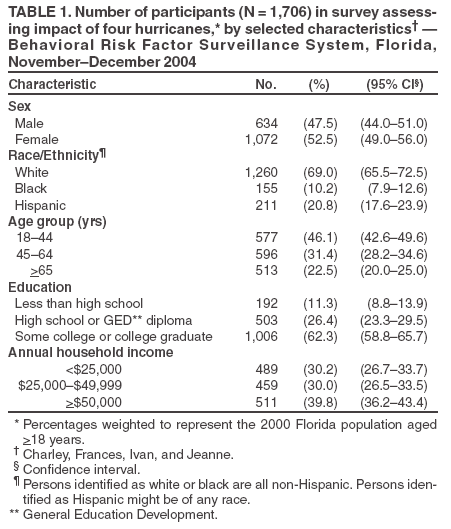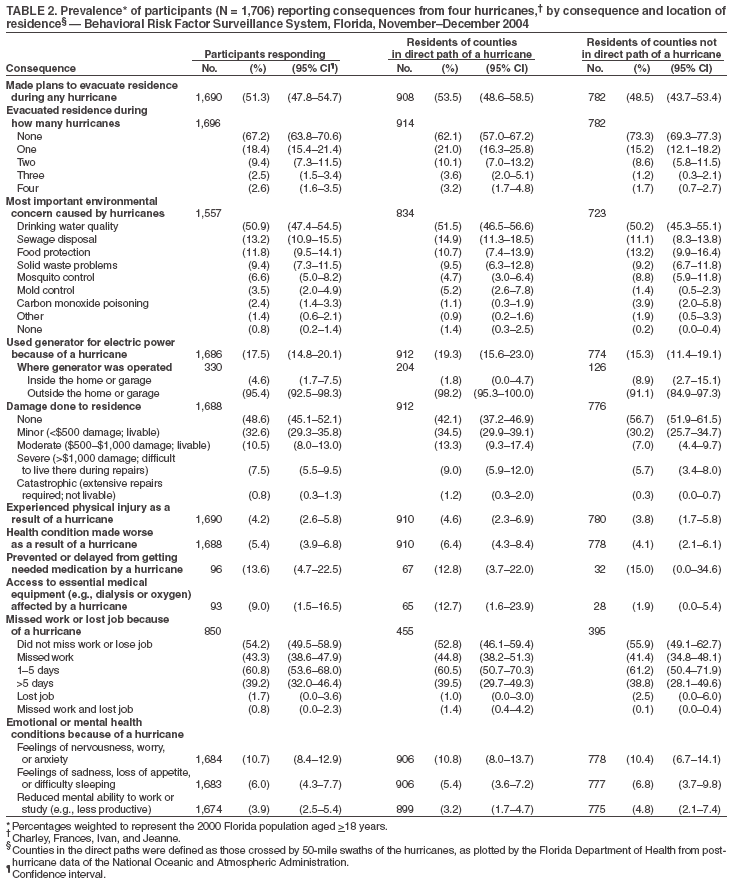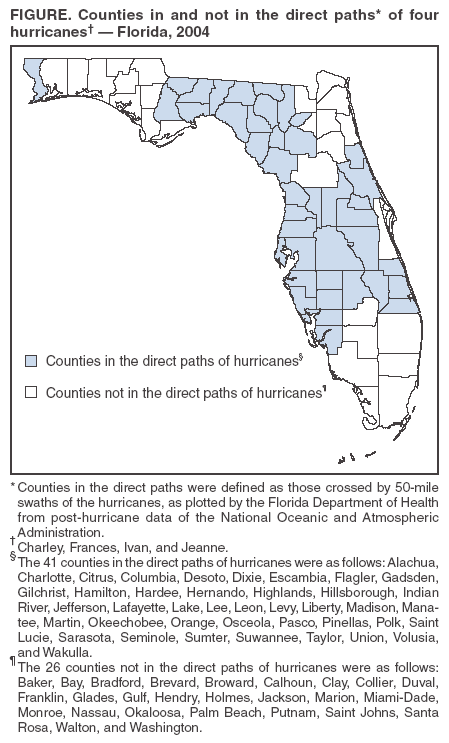 |
|
|
|
|
|
|
| ||||||||||
|
|
|
|
|
|
|
||||
| ||||||||||
|
|
|
|
|
Persons using assistive technology might not be able to fully access information in this file. For assistance, please send e-mail to: mmwrq@cdc.gov. Type 508 Accommodation and the title of the report in the subject line of e-mail. Epidemiologic Assessment of the Impact of Four Hurricanes --- Florida, 2004During August 13, 2004--September 25, 2004, Florida experienced four major hurricanes: Charley and Frances (both Category 4) and Ivan and Jeanne (both Category 3).* An estimated 20% of homes throughout Florida were damaged by these hurricanes (1), and 124 persons died (2). In October 2004, the Florida Department of Health (FDOH) added 30 questions to the Behavioral Risk Factor Surveillance System (BRFSS) survey to assess the impact of the hurricanes on state residents. This report summarizes the results of that survey, which indicated that 48.7% of Florida residents had no evacuation plan before any of the hurricanes, portable generators were used in 17.5% of homes after electric power outages, and residents of counties not in the direct paths† of the four hurricanes had consequences similar to those who lived in the direct paths of the hurricanes (e.g., physical injuries, barriers to medical treatment, and loss of work days). Public health officials should consider the needs of residents both in and not in the direct paths of hurricanes in their preparedness planning. BRFSS is a state-based, random-digit--dialed telephone survey of the noninstitutionalized U.S. population aged >18 years (3). During November--December 2004, interviews were conducted with 1,706 Florida residents. Among the participants, 919 (53.9%) lived in the 41 counties in the direct path of at least one of the four hurricanes, and 787 (46.1%) lived in the 26 counties not in the direct paths of the hurricanes (Figure); participants represented all 67 counties in Florida. Chi-square tests were used to examine differences in prevalence between those living in the two groups of counties. Response rate was 42.5%; data were weighted by sex, age, and race/ethnicity to represent characteristics of the 2000 Florida population (4,5), with the weighted result that 52.5% of participants were women, 69.0% were white,§ and 62.3% had at least some college education (Table 1). Overall, 51.3% of Florida residents reported having evacuation plans before the hurricanes; results were similar for residents of counties in the direct paths of hurricanes (53.5%) and those not in the direct paths of hurricanes (48.5%) (Table 2). More than one third (37.9%) of Floridians living in the direct paths evacuated their homes for at least one hurricane, compared with 26.7% of those not in the hurricane paths. Among the 67 counties in Florida, 44 (65.7%) ordered mandatory evacuations for at least one hurricane; an additional 15 counties ordered voluntary evacuations for at least one hurricane. Evacuation orders varied; for example, during Hurricane Charley, Hillsborough County had a countywide mandatory evacuation order, whereas neighboring Pinellas County had a mandatory evacuation order for nursing homes only. Environmental concerns associated with hurricanes cited as most important by all respondents were drinking water quality (50.9%), sewage disposal (13.2%), and food protection (11.8%). No statistically significant differences were observed between residents living in counties in or not in the direct paths of the hurricanes. Overall, 17.5% of occupied Florida residences used a portable, gasoline-powered generator for electric power after hurricanes; no significant difference was observed between persons living in counties in or not in the direct paths of the hurricanes (19.3% versus 15.3%). Among persons using generators, 4.6% reported operating them inside a home or garage (1.8% in the hurricane paths and 8.9% not in the hurricane paths, respectively). Among all respondents, 51.4% reported some damage to their homes, including 43.3% of those who were not living in counties in the direct paths of the hurricanes. Severe or catastrophic damage was reported by 10.2% of persons in the hurricane paths and 6.0% not in the hurricane paths (Table 2). Among the 850 survey participants who reported being employed or self-employed and who responded to questions about employment after the hurricanes, 45.8% missed work, lost their jobs, or both because of the hurricanes, and 39.2% were out of work for more than 5 days. Among those in the hurricane paths, 47.2% missed work, lost their jobs, or both, and 39.5% missed more than 5 days of work. Among Floridians not in the hurricane paths, 44.1% missed work, lost their jobs, or both, and 38.8% missed more than 5 days of work. Physical injuries caused by the hurricanes were reported by 4.6% of persons in the hurricane paths and 3.8% not in the hurricane paths. Among persons with health conditions such as diabetes, asthma, or cardiovascular disease, 5.4% reported their conditions were made worse as a result of the hurricanes, including 6.4% in the hurricane paths and 4.1% not in the hurricane paths. Among those who said their health conditions were made worse by the hurricanes, 13.6% reported being prevented or delayed by the hurricanes from obtaining medication, and 9.0% reported barriers to accessing essential medical equipment (e.g., dialysis or oxygen). Persons living in counties in the hurricane paths were more likely (12.7%) to report difficulty in accessing essential medical equipment than persons not in the hurricane paths (1.9%). Emotional and mental health conditions were assessed during the interviews to determine whether any resulted from the hurricanes. Among all respondents, 10.7% reported feelings of nervousness, worry, or anxiety at the time of the interview because of the hurricanes; 6.0% reported feeling sad or having loss of appetite or difficulty sleeping; and 3.9% reported reduced mental ability to work or study. Reported by: MA Bailey, MSW, R Glover, MS, Y Huang, DrPH, Bur of Epidemiology, Div of Disease Control, Florida Dept of Health. Div of Adult and Community Health, National Center for Chronic Disease Prevention and Health Promotion, CDC. Editorial Note:The results of this assessment of the 2004 hurricane season in Florida underscore the need to improve certain areas of hurricane preparedness planning. Approximately half (48.7%) of Floridians had no evacuation plan before any of the hurricanes, including those who resided in counties in the direct path of a hurricane. Efforts should be increased to educate the public regarding the need to evacuate residences not only in the direct paths of hurricanes but also residences away from the direct paths where hazards are posed (e.g., flooding). Survey results also indicated that portable generators were used for electric power in an estimated 17.5% of occupied Florida residences. Among persons using generators, 4.6% reported operating them improperly inside a home or garage. Surveillance data from this period identified 56 reported carbon monoxide--exposure incidents, resulting in treatment of 167 persons and six deaths (6). During the 2004 hurricane season, FDOH periodically released notices regarding the dangers of carbon monoxide poisoning, especially involving the use of portable generators. Public education regarding the proper use of generators and the dangers of carbon monoxide should be increased to reduce the risk for exposures throughout the hurricane season. The findings in this report are subject to at least five limitations. First, the sample size of 1,706 was too small for strata analyses, particularly regarding difficulties faced by adults with chronic conditions and treatment sought by those reporting emotional or mental health conditions. Second, the response rate for the survey was 42.5%. Third, the sample design for the Florida BRFSS did not provide county-level data to assess local impact of the four hurricanes. However, other reports have addressed local impact of specific 2004 hurricanes and the needs of target populations, such as older adults (7--9). Fourth, BRFSS does not reach residents who are temporarily or permanently without a land-line telephone, and interviews by cellular telephone are prohibited. Finally, no baseline data were available to compare the emotional and mental health conditions reported by survey participants as a result of the hurricanes with their conditions before the hurricanes. The findings in this report suggest that BRFSS can be used for rapid assessment of the impact on the lives of residents and the public health consequences of hurricanes. Timeliness of implementing such surveys can be critical to the accurate assessment of conditions directly related to the hurricanes. Within 30 days after the last Florida hurricane of 2004 (Hurricane Jeanne), FDOH began collecting these data, which might not have been captured by other means. Collaboration among state agencies was essential to developing a comprehensive assessment tool. Hurricane preparedness by FDOH now includes educating residents about the danger of carbon monoxide poisoning, planning for mosquito control, and making available a family preparedness guide. Additional information is available at http://doh.state.fl.us. Acknowledgments The findings in this report are based, in part, on contributions by the Florida Dept of Children and Families Adult Mental Health Program; Florida Behavioral Risk Factor Surveillance System Working Group; Bur of Chronic Disease Prevention and Health Promotion, Div of Environmental Health, Florida Dept of Health. References
* On the Saffir-Simpson Hurricane Scale, Category 4 hurricanes are those with wind speeds of 131--155 miles per hour (mph), and Category 3 hurricanes are those with wind speeds of 111--130 mph. † Counties in the direct paths were defined as those crossed by 50-mile swaths of the hurricanes, as plotted by FDOH from post-hurricane data of the National Oceanic and Atmospheric Administration. The 41 counties in the direct paths of hurricanes were as follows: Alachua, Charlotte, Citrus, Columbia, Desoto, Dixie, Escambia, Flagler, Gadsden, Gilchrist, Hamilton, Hardee, Hernando, Highlands, Hillsborough, Indian River, Jefferson, Lafayette, Lake, Lee, Leon, Levy, Liberty, Madison, Manatee, Martin, Okeechobee, Orange, Osceola, Pasco, Pinellas, Polk, Saint Lucie, Sarasota, Seminole, Sumter, Suwannee, Taylor, Union, Volusia, and Wakulla. The 26 counties not in the direct paths of hurricanes were as follows: Baker, Bay, Bradford, Brevard, Broward, Calhoun, Clay, Collier, Duval, Franklin, Glades, Gulf, Hendry, Holmes, Jackson, Marion, Miami-Dade, Monroe, Nassau, Okaloosa, Palm Beach, Putnam, Saint Johns, Santa Rosa, Walton, and Washington. § For this report, persons identified as white or black are all non-Hispanic. Persons identified as Hispanic might be of any race. Table 1  Return to top. Table 2  Return to top. Figure  Return to top.
Disclaimer All MMWR HTML versions of articles are electronic conversions from ASCII text into HTML. This conversion may have resulted in character translation or format errors in the HTML version. Users should not rely on this HTML document, but are referred to the electronic PDF version and/or the original MMWR paper copy for the official text, figures, and tables. An original paper copy of this issue can be obtained from the Superintendent of Documents, U.S. Government Printing Office (GPO), Washington, DC 20402-9371; telephone: (202) 512-1800. Contact GPO for current prices. **Questions or messages regarding errors in formatting should be addressed to mmwrq@cdc.gov.Date last reviewed: 7/20/2005 |
|||||||||
|